 HALF TRACK CAR M3
HALF TRACK CAR M3
Armoured transport - USA. About 56 500 built 1940-45.
Genesis : The T7 and Kégresse tracks system.
French carmaker Citröen already worked on half track cars developed by engineer Adolphe Kégresse, which produced modified Rolls-Royce and Panhard derivatives for the Tsar, just before WW1. Citröen made a mediatic coup with its famous worldwide trip, "Paris-Pékin" also known as the "yellow cruise", and betwen 1921 and 1937, the French army adopted them as well, as the polish army and other countries under licence. US Army bought several Citröen-Kégresse for evaluation in the late twenties and developed their own system, still retaining the original flexible belt track. The first prototype, the T7 was the forerunner of a famous lineage of 70 versions and a production of 41 000 vehicles during WW2. The T7 ordered by US Ordnance department, which searched for a prime mover and reconnaissance vehicle, and was developed by White company to extensively test and improve the Kégresse tracks system, with their custom chassis and the body and parts of their M3 Scout car, already in production. The T9 Half-Track truck, another prototype which was deemed too heavy, gave its Timken rear bogie assembly to the T7, and the lighter vehicle seemed successful on trials. But beeing underpowered, the T7 was reequiped with a more powerful car engine, eventually giving the T14 final prototype, which was the blueprint for the serie M2 Half Track Car.Caracteristics : A derivative of the M3 Scout Car.
The M3 Scout car was another successful product of the White Motor Company of Cleveland. It was devised as a main scout armoured car for the US Army, by a request from the US Army Ordnance department. Its main feature was a four wheel drive, four-speed manual constant-mesh (non-synchromesh) transmission. Its hull was armoured (mostly on the front), and it has vacuum-assisted power brakes. Assembly was made by bolting. After an initial preserie of 64 machines in 1939 for the 7th cavalry brigade, an improved M3A1 version was soon designed for mass production. Nearly 21 000 were built until 1944. It gave many elements to the M2 Half track, and the strong family tree resemblance of the three armoured tranports (with the M3), and a strong standardization which helped to reach the objectives of cheap production and easy maintenance. The entire hull, brakes, transmission, forward axle and wheels, machine guns fixations and even the bumper unditching roller were retained for the M2. Although longer, many thought in 1939 that the M2 was basically a Half Track version of the M3 Scout Car. Ground clearance was 11.2 inches (28,4 cm). The White 160AX was a 6 cylinder, 4 cycle, in-line gasoline, with a net horsepower of 147@3000rpm, and a 325 ft-lb@1200rpm torque. Standard fuel capacity of 60 gallons (230 L). Max speed on road was 45 mph (72 kph). Turning diameter was 18m, max vertical obstacle 30cm and fording depht 81cm. Front axle had Semi-elliptic longitudinal leaf spring, with steel ventilated disc, and at the rear, vertical volute spring, one bogie/track; 4 dual/bogie with 18-tooth front drive sprockets, and adjustable fixed idlers at the rear of the track. This latter was a center guide band type, 12 inches wide, with a 4 inches pitch, 58 picthes in all, and a total ground contat lenght of 46.75 inches (1,18 meters). The front wheels could be engaged for cross-country travel.Main production and M2A1
All elements from the prototypes, T9, T7 and T14 were reworked to make the first preserie vehicles. In 1941, the first units were equipped with this armoured transport, some beeing based in the philippines. A total M2 production of 11,415 (From White motor co. and Autocar Co.), a few of them beeing improved M2A1 (which quickly gave place to the M3), were built throughout the war, with many sub-versions, a total of 13 500 M2 in all. They all have in common the "short hull" derived form the M3 scout car, relatively weak armor on the sided, but stronger, with thick Rolled face-hardened steel plates at the front, folded protective panels with loopholes for the drivers protection around the driving compartment, with ammunition stowage behind accessible from the insied or external side panels. The headlights were mounted on the fenders, but this proved fatal on gun-equipped versions. There was a roomy open trolley equipped with retractable seatings, munitions cases, spare parts, and fixations for two types of machines guns : The heavy Browning 50 cal. M2HB (12,7 mm) and up to three Cal.30 M1919 A4 (7,9 mm) Mgs, with flexible on skate mounts, later pintle mounts. The main cal.50 was mounted forward, just over the assistant driver seat. It was an anti-aircraft and anti-personal 360° M49 ring mount. This provided them an excellent firepower, although the main critic about them beeing the weakness of the amovible trolley upper side panels, which were not always able to stop Mg34 and Mg42 bullets... Provision was 700 rounds for the main caliber, and 7750 for the others. Depending on versions, additional storage racks were added for extra bogie wheels, iron cable, or extra ammunition and fuel cases. Nearly all, from the beginning, included the frontal unditching roller, shovel and pickaxe, and fixations for fuel cans. A towing device at the rear allowed them to tract standard m2/M3 Howitzer and other light guns. The M2A1 had also smaller, demountable headlights on either side of the hood, and optional anti-ditching roller or a 10,000lb (4500kg) capacity, and mine racks behind the ammunition stowage compartments. Total production of the M2A1 was of 1643 machines, and 1266 later converted.Versions of the M2 Half Track.
With a figure of eleven versions and many sub-versions, the M2 was itself a testbed for many configurations, despite beeing not armoured enough for front-line operations. These changes concerned first and foremost infantry support, added firepower, and adaptations for speficic tasks. The first M2 model were equipped with a single, forward cal.30 Mg. As it was soon found unsufficient, a forward M2HB cal.50 on a skate rail mount derived from the M32 truck quickly became the trademark of the M2; Other sockets for skate mounts were placed, up to three additional cal.30 Mgs. The M2A1 introduced the M49 mount for the main caliber and pintle mounts for the secondary Mgs. The M9 (M2E5) was the lend-lease version produced by the Harverster Co. with a longer hull and rear access doors, and somewhat different internal configuration. The M9A1 was a sub-version introducing the improvements in gun mounts of the M2A1. There were also two self-propelled artillery versions, the mortrar one beeing the M4 and M4A1 sub-version with a 81 mm M1 mortar fixed forward inside the crew compartment, and the M2W equipped with 37 mm antitank guns with their protective shield, mounted forward (replacing the 50 cal. MG). AA versions included the prototypes T1 (and sub-vesions T1E1 to E3) with Bendix and Maxon mounts and a Martin turret and partial hard-top. Also the T28 CGMC with a single 37 mm autocannon M1A2 AA which was thoroughly tested and gave birth to the M3-based T28E1. There was also the T10, featuring a Hispano-Suiza HS.404 20 mm cannon, which was also later used for the T10A1 adapted for the M3 chassis. All these AA experimental versions gave later successful M3 serie conversions.
M3 Half Track.
As the M2 was initially conceived as an artillery tractor, with only space for the gun crew, the M3 received in late 1940 a longer body to accomodate a full platoon of thirteen riflemen and their equipment. The access was performed at the back door, and the galley part of the hull didn\'t incorporated an ammunition hold. It was simplified for mass production, as well as other parts of the hull, but the wheelbase and other general caracteristics remains unchanged. The M3 was produced by the Autocar Company, Diamond T Motor Company, and the White Company until the end of the war. It was fitted first with the reliable White 160 Ax 386 Cu in (3660 cc), a gasoline six cylinder with a compression ratio of 6:3:1. and a power to weight ratio of 15.8 hp/ton. But soon a more powerful array of IHC engines was available, and many later versions were remotorized until the end of the war. First gun mount was the pintle model Cal.50 M2 heavy machine gun, and two other pintle mounts at the inner hull sides. This early arrangement was replaced by the "pulpit mount" M49 for the cal.50, as well an an extra aerial pintle mount for a third cal.30. The M3A1 which appeared in 1941 integrated additional protection, in fact all the hull was now armored, but as it appeared, many complaints rose about the lack of protection offered by these armored panels, as these Half-Tracks were infamomusly dubbed "Purple Heart Boxes" (this decoration was offen offered postumously). It appeared that machine gun fire could pierce it anyway, and the lack of roof protection was critical with shrapnells and airburst shells. Only in 1944 these armoured panels received extra amovible protection... Over 41 000 M3 were built, plus 2000 M5 by International Harverster Cie for lend lease-exports, with a IHC RED 450B engine, modified drive train and electrical and fuel systems.
M3 variants.
Like the M2, but even more, the M3 was adapted for many purposes. Besides the regular M3 and M3A1, and the late (never produced) M3A2, they were three specific variants for lend-lease : The M5 provided to Great Britain, USSR, Canada and France, with sub-versions M5A1, M9 and M9A1 which differed by some equipments, fittings (inspired by the M2), radio access and rear doors, racks... All were regular troop transports. The two main specific variants of the war were gun carriers and anti-aircraft models.
The Self propelled guns (or SPG) were the T12/M3 and T12/M3A1 HMC equipped with the M1897 A5 75 mm howitzer and its gun carriage, with a special-purpose shield in later versions. This gun stock was exhausted and new variants appeared, the T12 GMC equipped with a 75 mm long barrel or 105 mm for the USMC, the T48 and T30 GMC for the US army equipped with, respectively, the 57 mm M1 tanks destroyer (US adaptation of the British QF 6-pounder antitank gun) and 75 mm M1A1 Howitzer, and the T19 equipped with the M2A1 105 mm Howitzer. The T19 gave also a mortar version, equipped with the 81 mm or M21 MMC.
Anti-aircraft versions were highly successful, developed upon M2 special versions and experiments. The M13 MGMC was the first one, with sub-version M14, fitted with Maxson M33 double mount, for two cal.50 M2HB and 5000 rounds in store and removable side panels. The M14 was based on the M5 chassis, for Lend-Lease, and was provided to Britain. The M16 MGMC was probably the best known and most prolific with its new Maxson quadmount M45D (four modified 50 caliber M2HB Mgs). It gave three sub-variants, the M16A1 with fixed armored panels and M16A2 with minor modifications and the M45F improved quadmount. The M17 sub-variants was based on the M5 and exlusively provided to Soviet Union. The T28E1 was a special purpose version equipped with a single 37 mm cannon M1A2, assisted by two cal.30 M2WC Mgs. It gave two sub-versions, M15 and M15A1 with minor modifications. There were also several prototypes fitted with the 40 mm bofors canon, but the recoil was such that all but one existed only as prototypes. The Australian M15 "special" was the only turreted version succesful enough to see mass conversions. All were used in the south pacific.
The M2 and M3 in combat.
The M2 was adopted by the US Army and Marines and was found in all theaters of war, North Africa, Europe and the Pacific. It proved reliable and versatile, and was fielded to the British and Commonweatlh forces under lend-lease, as many reconstructed allied forces (Free French, Polish, etc.). The International Harvester Company mad an additional 3500 M9 (an export version of the M2), from which 800 (with some M2) were allocated to the Soviet forces. At the end of the war, many surplus lend-lease models were sold to South American countries, some retained their models, with many modifications, until 2009... In all, the M2 was known to have been used by twenty countries, including Czechoslovakia, Chile, France, Greece, Portugal, Brazil, Poland, Israel, Mexico, Nicaragua, Belgium, Netherlands, Cambodia, South Vietnam, Laos, Argentina, and Lebanon. Israel was given many Half-Tracks and converted them in many variants, A to D with improvements over years, culminating with the TCM-20,the last modified version. They are still in service today.
| Specs. | M2 |
M3 |
| Dimensions : | 5,96 x 2,20 x 2,26 m | 6,18 x 2,22 x 2,26 m |
| Total weight, battle ready : | 9 Tons | 9,3 tons |
| Crew : | 2+7 passengers | 3+10 passengers |
| Propulsion : | White 160 AX petrol 147 bhp | White 160AX/IHC RED 450 147/160 bhp |
| Speed : | 40 mph (63 kph) road 25 mph (43 kph) off-road |
45 mph (72 kph) road 28 mph (47 kph) off-road |
| Range : | 320 km (at cruise speed -50 kph) | 382 km (175 mi) |
| Armament : | Main : Browning M2 Cal.50 sec. 2 Cal.30 M1919 Mgs. |
Main : Browning M2 Cal.50 sec. 2 Cal.30 M1919 Mgs. |
| Armour : | From 6 to 12 mm | From 6 to 12 mm |
| Total production : | 13 500 | 43 000 |
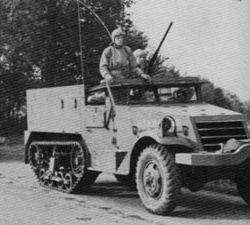
A rare picture of a M2 Halftrack of the early production, somewhere in north africa.
Links
The M2 Half Track on Wikipedia
General characteristics and some pictures
Interesting gallery of many M2 and M3 variants.
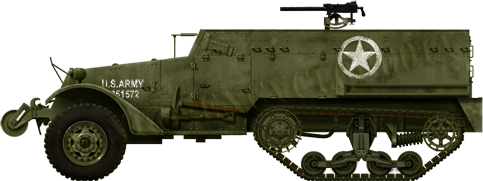
First preserie M2 with a unique cal.30 Mg in a central pedestal mount. This was the original gun tractor, with just enough room for the gun crew and large ammunution holds. These were used primarily for carrying M1927 Pack Howtitzers to the battlefield. Here is a model used by the USMC in the Philippine, december 1941.
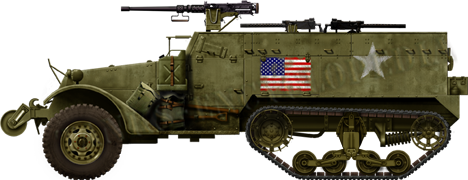
A M2 with the original Skate mount in Algeria, november 1942.
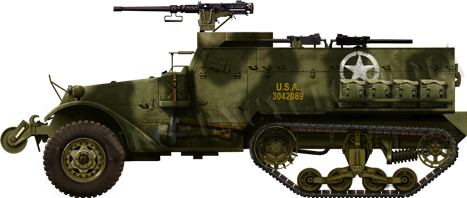
M2A1 with the M48 gun mount and cal.30 pintle mounts. France, june 1944.
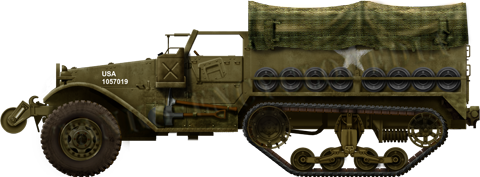
Early production M3 with a top canvas, Italy, 1944.
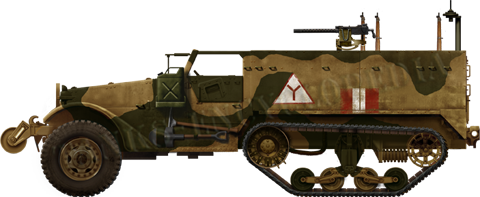
A British M5 (the lend-lease version built by International Harverster) of the VIIIth army, Tunisia, january 1943.
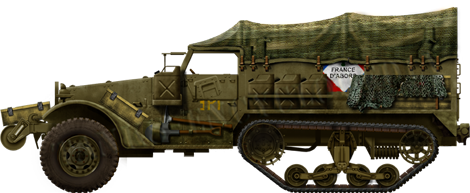
Half Track M5 of Free French first army, southern France, august 1944.
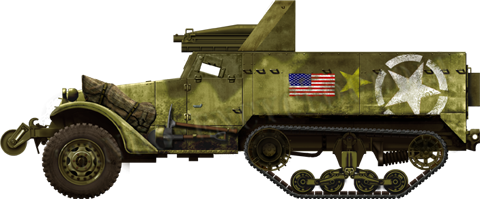
M3 75 mm HMC equipped with the famous "pack howitzer", Palermo, Sicilia 1944.
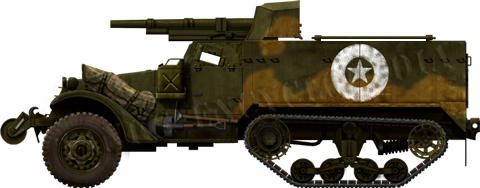
The T12 was the main gun motor carriage derivative of the M3, equipped with the 105 mm guns, mostly used by the USMC. Previously regular T12 were equipped with M1897A4 75 mm gun (T12 GMC), an american version of the french famous "canon de 75". When the stocks were exhausted, they turned to more modern 105 mm. Over 2200 GMCs were built prior to april 1943, but only 842 seems to have seen service as is. The M1897 had an indirect fire range of 9,200 yd (8,400 m), and provision was 59 rounds, either AP M72 (Armor Piercing), APC M61 (Armor Piercing Capped) and the high-explosive antipersonal HE M48. This illustation depicts a first US army GMC stationed in Sicilia, 1943.
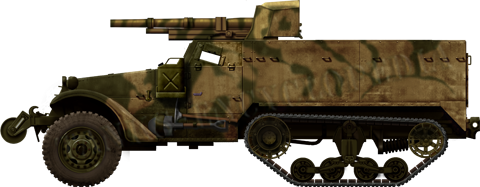
M3 75 mm GMC in North Africa, US first division, Tunisia, june 1943. The medium velocity of this gun (AP projectiles were able to pierce only 7,1 to 8,1 mm of armor at 500y (460m), made it unsuitable for most Panzers in 1943. Most of them were rather used for artillery support. GMCs were also used by the USMC in the pacific theater, with better success against Japanese tanks. They seen action at Peleliu, Tarawa, Saipan and Okinawa, were they replaced tanks in infantry support.
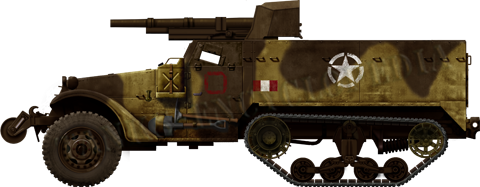
T12 GMC in British service, Eight Army, Tunisia, may 1943.
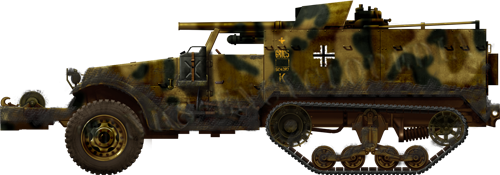
Captured M3 T48 GMC, equipped with the M1 57 mm antitank gun. It was an american-built version of the Ordinance QF 6-pounder of the British army, used thoughout the war.
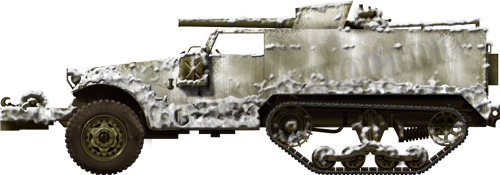
The T48 GMC was a tank hunter, one of the most succesful conversions of the M3 Half Track. It was put into production in december 1942, and 962 in all seen service, while 281 M3A1 were also converted on the stocks. Each of them was fitted with the high velocity M1 57 mm (six pounder) antitank gun, with a provision of 99 AT rounds and 22 grenades.
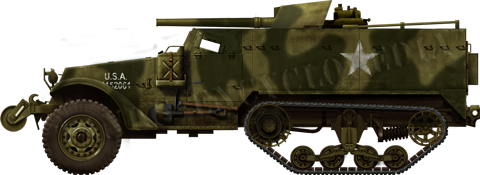
A T48 GMC in service with Patton army, Operation Cobra, Normandy, july 1944.
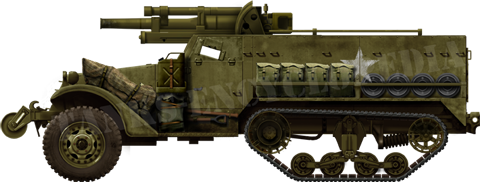
A regular T19 Howitzer Motor Carriage, based on the M3 chassis, and equipped in a very similar fashion that the former 75 mm HMC it just replaced. With its long barrel and heavier shells of high explosives, it was well suited to add firepower where it was needed. The T19 105mm HMC was not a high production vehicle, around 400 were operated in all. But the punishing fire of the 105 mm Howitzer, mounted in the most cost-effective solution yet, were a potent combination.
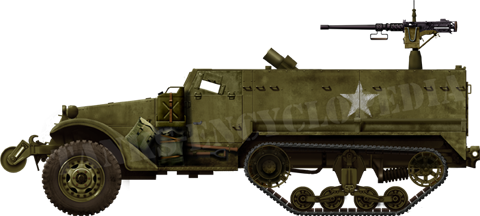
The M4 MMC was a new concept, entirely refurbished to operate a single regular ordinance 81 mm mortar. It was accepted in service in october 1940 and 572 were built. Later on, the evolved version came, as the M4A1, which allowed fire in movement, but the mortar was still firing from the rear. It was put in production in december 1942 and 600 were built. They were respectively based on the M2 and M2A1, but then the Ordnance Department decided to exploit th M3 chassis, which came with the M21. The mortar was now forward firing, with a reinforced basis which allowed wide angle fire. But moreover, there was now a defensive Cal.50 placed at the rear. But only 110 were built, in early 1944. The T21E1 which came after was an experimental new version. It was superseded by a 107mm MMC version.

The M13 (and subversion M14) were first really successful AA adaptation of the Half Track M3, using the maxon M33 twin mount, operating M2HB cal.50 heavy machine guns, with very good results against low-flying aircrafts. Side panels were foldable to allow a beter arc of fire, and of course all the internal compartment was refurbished. They were accepted in january 1943 and 1103 Half-tracks were built as M13, and later, 628 converted into quad-mount M16 on these stocks.
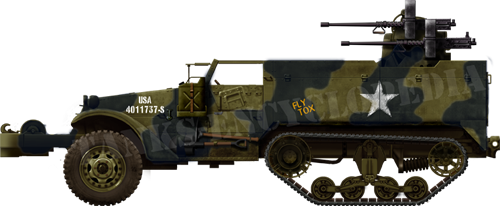
The "quad-mount" or "quad 50" version is probably the best-known and most prodced of these AA variants of the M3. Based on a new M50 mounting, it has excellent capabilities against low-flying aircrafts and quickly gained the nicknames of "meat chopper" and "Krautmower". This mount allowed fast moving, high rate of fire of the highly reliable 50cal. heavy machine guns, most of the time with the new side panels folded. It was accepted in service in may 1943 and no less than 2877 were built, plus 628 converted from M13 stocks, and 109 from twin 20 mm GMCs. They served in Tunisia, Italy, France and germany, but also in the pacific.

WW2 Tanks




























WW2 tanks posters

All Tiger tanks liveries.

Panther liveries and variants

WW2 Armour - All tanks











Tanks aces and single tanks series

Find more there

Museums, Movies, Books & Games
The Tanks and Armor in pop culture
Tanks and armored vehicles in general are only really grasped when seen first person: The mass, the scale, it's all there. Explore also the way tanks were covered in the movie industry, in books and in video games.Movies:
Best tanks movie on warhistoryonline.com
On imdb.com
On bestsimilar.com/
miltours.com
liveabout.com/
watchmojo.com
Video Games:
pcgamesn.com
historyhit.com
levvvel.com
vg247.com/best-tank-games
mmobomb.com/
alienwarearena.com
